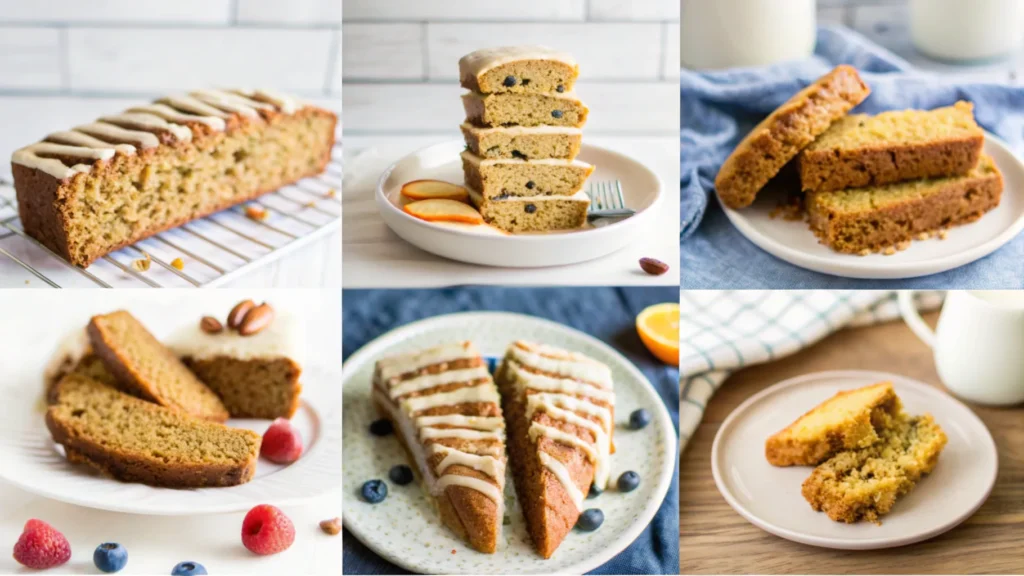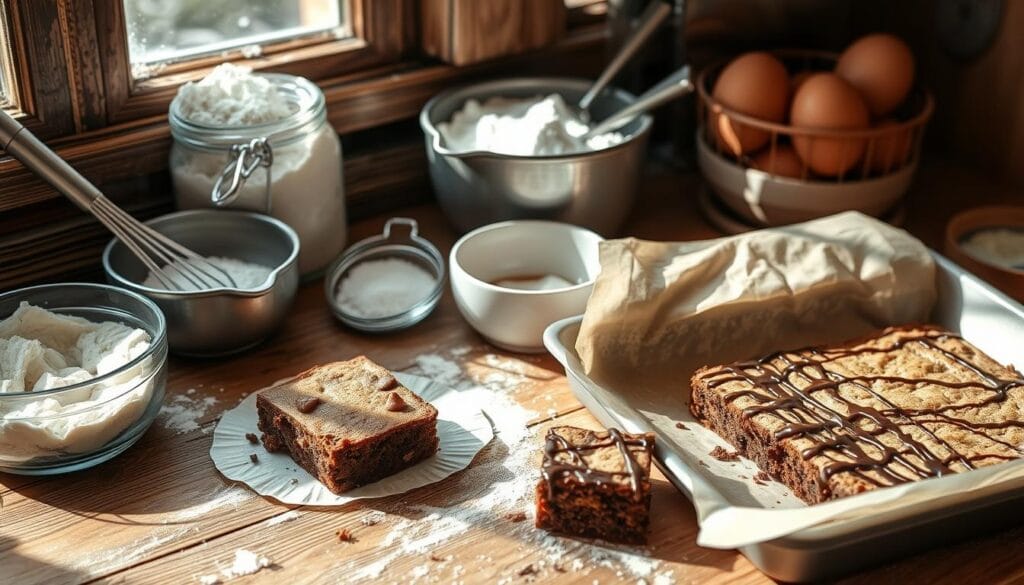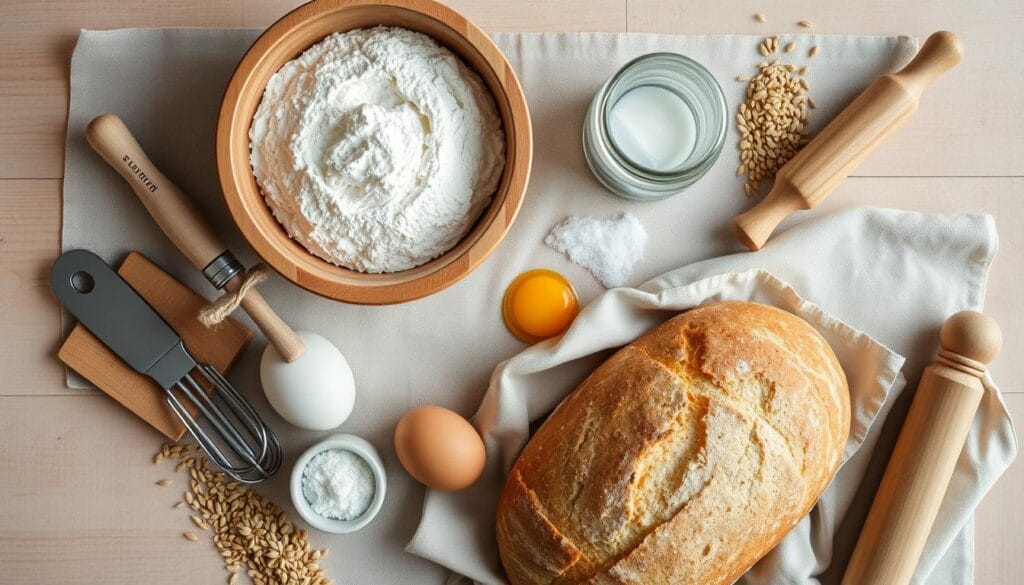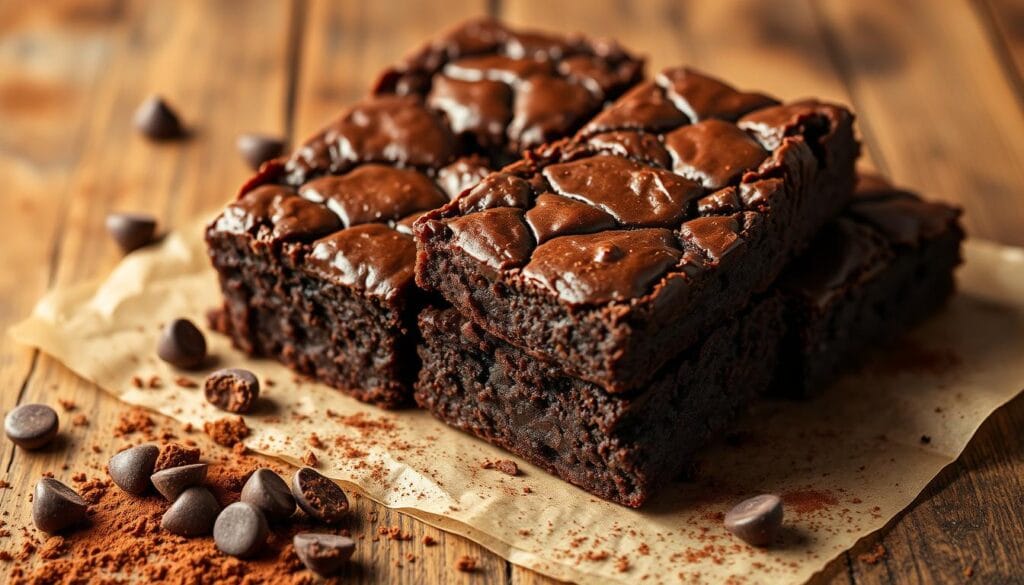
Ever looked at your sourdough starter and thought, “Is there more to life than bread?” Imagine turning your kitchen into a sweet lab. Here, leftover starter makes amazing sourdough desserts that wow everyone.
Baking with sourdough is more than tangy loaves now. Sweet treats are getting a tasty boost. Your leftover starter can make incredible cookies, cakes, and brownies. These desserts add depth and complexity to traditional sweets.
Sourdough desserts are a culinary adventure. The fermentation process adds a subtle tanginess that makes every bite special. Whether you’re an experienced baker or just starting, these recipes will change how you see sweet treats.
Table of contents
Understanding Sourdough in Sweet Baking: Explore Sourdough Dessert Recipes
Diving into sourdough desserts opens a world of flavor and texture. It changes traditional baking. Your baking can get better by using sourdough discard and active starter in treats.

Sourdough isn’t just for bread anymore. Professional bakers use it for rich, complex desserts. These desserts excite the taste buds.
Benefits of Using Sourdough Discard in Desserts
Using sourdough discard in desserts brings unique benefits:
- Adds deep, tangy flavor to sweet recipes
- Reduces food waste by repurposing starter discard
- Introduces natural fermentation benefits
- Enhances moisture in baked goods
Active Starter vs. Discard in Sweet Recipes
Knowing the difference between active starter and sourdough discard improves your desserts:
| Characteristic | Active Starter | Sourdough Discard |
|---|---|---|
| Flavor Intensity | Mild | Bold and Tangy |
| Leavening Power | High | Limited |
| Best Used In | Lighter Desserts | Dense Baked Goods |
How Sourdough Affects Dessert Texture
Sourdough changes dessert texture in amazing ways. Sourdough discard adds moisture and complexity. This makes baked goods tender and rich.
Sourdough isn’t just an ingredient—it’s a culinary adventure that turns ordinary desserts into extraordinary experiences.
Mastering sourdough in sweet baking makes desserts unique. They have depth and character.
Essential Tools and Ingredients for Sourdough Dessert Recipes
To make tasty sourdough desserts, you need the right tools and ingredients. Your baking tools and ingredients can make or break your desserts.

Now, let’s look at the tools and ingredients you need for baking sourdough desserts:
Essential Baking Tools
- Precise kitchen scale for accurate measurements
- Various mixing bowls (ceramic and stainless steel)
- Parchment paper for easy cake and cookie removal
- Quality baking pans in different sizes
- Silicone spatulas and whisks
Core Sourdough Ingredients
- High-quality all-purpose flour
- Active sourdough starter or sourdough discard
- Fresh eggs at room temperature
- Granulated and brown sugars
- Unsalted butter or neutral oil
- Pure vanilla extract
Choosing high-quality ingredients is key. Fresh, top-notch ingredients will make your sourdough desserts amazing.
“The secret to amazing sourdough desserts lies in using fresh, premium ingredients and precise measurements.” – Professional Baker
Pro Tip for Measuring
Get a digital kitchen scale for better results. Professional bakers say weighing ingredients is more accurate than measuring by volume.
| Ingredient Type | Recommended Quantity | Purpose |
|---|---|---|
| Sourdough Starter | 150-200g | Provides fermentation and unique flavor |
| All-Purpose Flour | 225g | Creates structural base for desserts |
| Granulated Sugar | 200g | Adds sweetness and helps with caramelization |
With these tools and ingredients, you’re ready to bake delicious sourdough treats. They’ll show off the sourdough’s tangy flavor.
Classic Sourdough Dessert Recipes: Brownies with Crackly Top
Sourdough brownies add a special twist to the classic chocolate dessert. They bring a unique flavor and texture that changes your baking. These treats mix the tanginess of sourdough with the rich chocolate everyone loves.

Achieving the Perfect Brownie Texture
To make amazing sourdough brownies, focus on a few key steps. The secret to a crackly top is in these steps:
- Use a metal baking pan for even heat distribution
- Properly dissolve sugar to create a smooth batter
- Avoid overmixing the ingredients
- Bake at the right temperature (typically 350°F)
Storage and Shelf Life Recommendations
Storing your brownies right keeps them fresh longer. Here’s how to store them:
| Storage Method | Duration |
|---|---|
| Room Temperature | 3-5 days |
| Refrigerated | Up to 1 week |
| Frozen | Up to 3 months |
Delicious Variations and Add-ins
Make your sourdough brownies even better with these mix-ins:
- Chocolate Lovers: Add dark or milk chocolate chips
- Nutty Twist: Mix in chopped walnuts or pecans
- Flavor Boost: Incorporate coffee or espresso powder
- Gourmet Touch: Swirl in Nutella or peanut butter
“The magic of sourdough brownies is in their ability to transform a simple dessert into a complex, flavorful experience.”
Pro tip: Use a kitchen scale to weigh your ingredients. It helps make the brownies more consistent and delicious.
Sourdough Sugar Cookies Guide: Easy Dessert Recipes
Explore the world of sourdough sugar cookies, a tasty way to use up sourdough starter. These cookies are soft and have a unique tanginess. They make traditional sugar cookies even better.
To make perfect sourdough sugar cookies, pay close attention to detail and use a few key techniques. Here’s why these cookies stand out:
- Chewy texture with crispy edges
- Rich flavor from sourdough discard
- Versatile recipe that uses excess starter
Essential Ingredients
| Ingredient | Quantity |
|---|---|
| Unsalted Butter | 226 grams (1 cup) |
| Granulated Sugar | 200 grams (1 cup) |
| Sourdough Discard | 160 grams (scant ¾ cup) |
| All-Purpose Flour | 330 grams (2 ⅔ cups) |
The secret to soft cookies is in the ingredients. Make sure your butter is soft and your sourdough discard is active. Cornstarch in the recipe makes the cookies tender and melts in your mouth.
“A great sourdough sugar cookie is all about balance – a hint of tang, a touch of sweetness, and a perfectly chewy texture.”
Baking Tips
- Chill the dough for at least an hour
- Use a kitchen scale for precise measurements
- Bake at 350ºF for 13-16 minutes
These sourdough sugar cookies are not only tasty but also versatile. Store them at room temperature for up to a week or freeze for up to 3 months. Each batch makes 18-20 large cookies, so you’ll have plenty to enjoy or share.
Pro tip: Adding ¼ teaspoon of almond extract to your dough can make your cookies even more special. It adds a unique flavor that takes them from good to amazing!
Ultimate Sourdough Coffee Cake Recipe
Discover the magic of sourdough coffee cake, a delightful twist on the classic breakfast treat. It brings tangy depth and incredible moisture to your baking. This recipe transforms your sourdough discard into a memorable culinary experience that will elevate your morning routine.
Making the Perfect Crumb Topping
Creating an irresistible crumb topping is key for an authentic sourdough coffee cake. Your streusel should combine:
- 105 grams (3/4 cup) all-purpose flour
- 165 grams (3/4 cup) brown sugar
- 4 grams (2 teaspoons) ground cinnamon
- 84 grams (6 tablespoons) cold unsalted butter
- Optional: 120 grams (1 cup) chopped pecans or walnuts
Long Fermentation Method
The secret to a rich fermented cake batter is patient fermentation. Mix your ingredients and let the sourdough discard work its magic for 8-24 hours. This process develops complex flavors and improves the cake’s texture, creating a more nuanced and tender crumb.
“Fermentation transforms a simple coffee cake into a culinary masterpiece with depth and character.”
Serving Suggestions
Your sourdough coffee cake shines when served fresh and warm. Pair it with:
- A steaming cup of morning coffee
- Vanilla bean ice cream for a decadent dessert
- Freshly whipped cream
- A dusting of powdered sugar glaze
Pro tip: This cake stays fresh at room temperature for 24-48 hours and can be frozen for extended enjoyment.
Popular Sourdough Dessert Recipes
Explore the world of sourdough desserts that turn classic treats into amazing experiences. These sourdough treats are changing home baking, with unique flavors and textures that traditional recipes can’t match.
Your sourdough starter is key to making delicious sweets. Whether using an active starter or discard, these recipes will make your desserts stand out:
- Chocolate Sourdough Brownies
- Sourdough Sugar Cookies
- Chocolate Sourdough Muffins
- Sourdough Coffee Cake
- Chocolate Zucchini Sourdough Muffins
Each recipe offers something unique. Sourdough dessert ideas are not just about tang. They’re about creating deeper, more complex flavors that make desserts extraordinary.
Pro tip: Always use a bubbly, active sourdough starter for the best flavor and texture in your desserts.
When picking your sourdough dessert recipes, keep these tips in mind:
- Starter hydration level (100% works best for most desserts)
- Type of flour used in your starter
- Fermentation time
- Desired texture and flavor profile
Ready to elevate your baking? These sourdough treats will wow your family and friends with their unique flavors and textures.
Tips for Converting Traditional Desserts to Sourdough
Turning your favorite desserts into sourdough treats needs some careful planning. Learning how to change traditional recipes for sourdough can bring new tastes and textures to your baking.
When converting recipes, focus on two main things: liquid ratios and how long to ferment. These steps are key for making sourdough desserts work.
Liquid Ratio Management
Sourdough starter is very wet, so you’ll need to adjust liquid amounts in your recipe. Here are some tips for handling liquid ratios:
- Reduce other liquids by 25-30% to balance out starter moisture
- Check your sourdough starter’s hydration level carefully
- Start with less liquid and add more as needed during mixing
Fermentation Timing Strategies
Fermentation greatly affects your dessert’s taste and texture. Different sourdough methods need different rest times:
| Dessert Type | Recommended Fermentation Time | Flavor Intensity |
|---|---|---|
| Quick Breads | 2-4 hours | Mild |
| Cakes | 4-8 hours | Moderate |
| Complex Desserts | Overnight | Strong |
Remember, converting recipes is an art. Each dessert reacts differently to sourdough methods. So, be ready to try new things and adjust your approach.
Pro tip: Always keep notes on your recipe modifications to replicate successful adaptations in the future!
Troubleshooting Common Sourdough Dessert Issues
Working with sourdough desserts can be tricky. Knowing common problems helps you make treats that are both tasty and perfectly baked.
Identifying Sourdough Dessert Challenges
Fixing sourdough dessert issues needs careful watching and smart solutions. Here are the top problems bakers face:
- Sinking cakes with dense bottoms
- Brownies lacking a shiny top
- Inconsistent rising patterns
- Dry or overly wet texture
Solving Specific Baking Problems
When your sourdough desserts don’t turn out right, try these fixes:
- Temperature Control: Keep the room temperature between 70-75°F for best fermentation
- Ingredient Quality: Use fresh baking soda and a recently fed sourdough starter
- Mixing Technique: Don’t overmix, as it can make batters too flat
“Perfect sourdough desserts are about understanding your ingredients and respecting their fermentation process.”
If your starter seems flat, mix in equal parts flour and water. Keep an eye on your starter’s health and activity for great dessert results.
Seasonal Sourdough Dessert Ideas
Adding seasonal flair to sourdough baking is a fun adventure. It lets you make fruit desserts and holiday treats that are truly special. Using fresh ingredients and new techniques makes your sourdough creations stand out.
Summer Fruit Variations
Summer is the perfect time for baking with fresh fruits. Try these tasty recipes that highlight the season’s best:
- Sourdough berry galette with fresh strawberries and raspberries
- Peach and lavender sourdough coffee cake
- Blueberry sourdough muffins with crumb topping
Summer desserts get a boost from sourdough’s tangy base. It pairs perfectly with sweet fruits, adding a special touch to summer treats.
Holiday Favorites
Winter is the time for festive sourdough treats. These recipes use warm spices and rich flavors to create unforgettable dishes:
- Sourdough pumpkin bread with cinnamon swirl
- Gingerbread sourdough cake with cream cheese frosting
- Spiced apple sourdough crumble
“Seasonal baking is about celebrating ingredients at their peak and creating memories through delicious, handcrafted desserts.”
These recipes add a sourdough twist to holiday baking. They mix the tang of sourdough with cozy winter flavors. Whether you’re baking for summer or winter, sourdough opens up a world of possibilities.
Storage and Freezing Guidelines
Keeping sourdough treats fresh needs careful storage. Your homemade desserts can stay great with the right freezing and storage. Knowing these tips will let you enjoy your baked goods longer.
- Room temperature storage: Most sourdough desserts stay fresh for 3-5 days in airtight containers
- Refrigeration: Extends shelf life up to one week
- Freezing: Best for long-term preservation of individual portions
Here’s how to freeze baked goods:
- Cool desserts completely before packaging
- Wrap individual portions in aluminum foil or plastic wrap
- Place in freezer-safe containers or bags
- Label with date and type of dessert
“Proper preservation ensures your sourdough treats taste as fresh as the day they were baked.” – Baking Experts
Freezing tips for sourdough desserts:
| Dessert Type | Freezer Storage Time | Thawing Method |
|---|---|---|
| Brownies | Up to 3 months | Room temperature, 1-2 hours |
| Cookies | Up to 2 months | Room temperature, 30-60 minutes |
| Coffee Cake | Up to 1 month | Refrigerator overnight |
Pro tip: Always use high-quality, moisture-resistant packaging. This prevents freezer burn and keeps your sourdough desserts’ texture.
FAQs:
1. What is the biggest mistake with sourdough starter?
Neglecting to feed it regularly, causing it to become inactive or spoiled.
2. Is sourdough good for desserts?
Yes! It adds tangy flavor, enhances texture, and makes desserts like brownies and cookies unique.
3. What are the pros and cons of sourdough?
- Pros: Adds flavor, improves texture, reduces waste.
- Cons: Needs maintenance and recipe adjustments.
4. What are the benefits of sourdough discard?
Boosts flavor, enhances moisture, reduces waste, and adds nutrition to recipes.
Conclusion
Sourdough baking is more than just making bread. It opens up a world of sweet treats that make your kitchen fun. With over 30 sourdough dessert recipes, you can turn simple desserts into amazing ones. Sourdough adds a tangy flavor and unique texture to classics like chocolate chip cookies and vanilla sheet cakes.
Don’t just stick to traditional recipes. Try using sourdough discard to make moist and tasty desserts. You can make everything from chewy oatmeal cookies to rich chocolate cakes. Each recipe shows how versatile your sourdough starter is.
Keeping your sourdough desserts fresh is important. Store your discard in an airtight container in the fridge for up to 2 weeks or freeze it for 3 months. This makes it easy to make a treat whenever you want. Start making sourdough desserts and watch your baking skills grow with each delicious creation.
Exploring sourdough desserts is not just a trend. It’s a way to celebrate traditional baking in today’s kitchens. Your sourdough journey is endless, limited only by your creativity and desire to try new things.

1 thought on “Sourdough Dessert Recipes”